![]()
![]()
![]()
Use LEFT and RIGHT arrow keys to navigate between flashcards;
Use UP and DOWN arrow keys to flip the card;
H to show hint;
A reads text to speech;
28 Cards in this Set
- Front
- Back

#153 Chavín de Huántar Northern Highlands, Peru Chavin _____________________ Content: A religious site build by the Andean people in South America in the highlands. One of the most preserved of its kind. _______________________________ Style: In this site, the main, central areas were meant for ceremonial rituals and stella and stelle have been found under or around the buildings and Circular Plaza. There are very few dwelling meant for living spaces, although there is a labyrinth of underground tunnels connected beneath the site. Many of the underground passages house religious relics and sacred items that were not available at the time for the public to see or have immediate access to. Some of the relics in this site are embellished with yellow diatomite, a semi-precious stone found in the area. The site also has "canals" built in to channel sound, so that when the temple was in use, the sounds of the ceremonies could be heard all around the site. |
Context: In the sophisticated Chavin culture, there were advancements that pre-dated many of the famous ancient cultures in Europe and the Mediterranean. The civilizations of the Peruvian highlands and mountains had developed mummification, knew how to fire clay to create ceramics, all during the "Early Horizon" time period of South America. In Chavin de Hauntar itself, there is tangible development seen between the older and newer structures. The semi-precious stones and stone blocks used in the site show how the Chavin used the materials available to create their religious sites and items. |
|
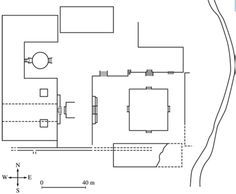
#153 Chavín de Huántar plan " " _____________________ Content: Floor plan of the site with scale and compass directions. _______________________________ Style: The site was orientated for accessibility aired the compass point directions. The entrance points to the Circular Plaza are pointed due east and due west, towards the sunrise and sunset.
|
Context: Because of the site's specific orientation around accessibility, it is believed that Chavin was a pilgrimage site for religious purposes. |
|

#153 Lanzón Stela In Chavin de Huantar _____________________ Cotent: Religious stone found underneath the old temple of Chavin de Haunter. _______________________________ Style: This piece is carved with anthropomorphic designs meant to show one of the Inka goddesses. |
Context: Not only was this stella found under one of the site's temples, archeologists also found offerings that had been placed at the foot of the stella as a form of worship. Just because the stella was under the temple, however, did not mean it was not seen. The stella was assessable through the tunnels built under the site. It is thought that the ancient people of Chavin would travel through the dark tunnels, most likely on hallucinogens, to worship at the foot of this stone that was believed to hold to power of the gods within it. |
|
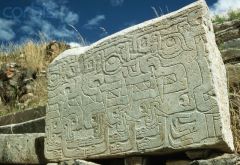
#153 Relief Sculpture In Chavin de Huantar _____________________ Content: Large, square stone that has been carved with simply, traditional South American designs. _______________________________ Style: The carvings consist of intertwining, anthropomorphic subjects. Everything has been etched into the stone using the substrative technique, but only in low relief. There is also a running inscription around the edges of the stone. |
Context: Even though the stone was only used for decorative purposes, its subjects of local birds and monkeys were most likely taken from the surrounding environment. This shows that the civilization new its surroundings and found significance in the animals. |
|
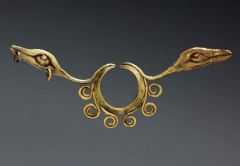
#153 Nose Ornament In Chavin de Huantar _____________________ Content: Golden nose ring with swirling designs and two bird heads. _______________________________ Style: Molded with linear designs and zoomorphic subjects, this ornaments achieves a flowing and simplistic design. |
Context: In the ancient Inka culture, nose ornaments were symbols of significance and power, either in an authoritative or religious way. The zoomorphic designs illuminated the understanding the people had of the animals the lived with and incorporated into their religions and culture. The use of gold and metalwork shows that he culture had accessibility to precious metals and had the technology and knowledge to be able to manipulate them. The availability of these same materials were, later, what attracted the interest of Spain and led to the raids of the conquistadors. |
|

#154 Mesa Verde cliff dwellings Montezuma Country, Colorado, U.S. Ancestral Pueblen/Anasazi 450 -1300 C.E. _____________________ Content: An Ancestral Pueblen cliff dwelling complex used for residential and religious purposes. _______________________________ Style: Built with a post-and-lintel structure, every block of these buildings were hand-cut. The Anasazi also used a technique called "chinking", in which they places thin slabs of stone in between the larger, stacked ones, which steadied the structures, allowed for curved walls and the creation of multiple stories. There were also pits built with surrounding stone walls, called "kivas" that would be covered with retractable, wooden ceilings. The kivas were only accessible by use of ladders and served as the place for religious ceremonies. |
Context: The main reason these dwellings were built under cliffs was to provide protection for the site from both the elements and invading tribes. It was also possible for the Ancestral Pueblos to create their agricultural plots on the top of the cliff so crops would have available sunlight and rain, but were also easy to reach. Kivas remained in the circular shape that is now often associated with ancient cultures and their religious beliefs, as it might have been considered the perfect shape. Because of the harsh and dry environment, sites like this one were almost always built near a water source, like a river or seep. |
|
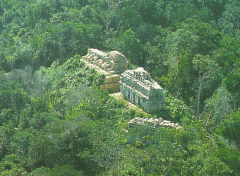
#155 Yaxchilán Chipas, Mexico Maya _____________________ Content: Ancient Mayan site built in the South American peninsula. _______________________________ Style: Built with hand-carved stone blocks, the buildings of Yaxchilán were more residential than those of Chavin. The site also has little underground tunneling, but has a similar religious significance. Within the site, most of the lintels of buildings are inscribed and decorated. |
Context: The ancient Mayan empire occupied the majority of a single peninsula, expanding back into the continent and housing several large city sites. Most of the separate cities and temples were actually warring factions of the same culture. The Maya were very advanced with expanding civilizations, agriculture, religion, temples, and mummification. Most of the temples built were stepped pyramids (a design seen in ancient Egypt before the smoothed construction of pyramids like those in Giza). The pyramids, much like the elevated ziggurats in the ancient middle east, were created in accordance with the religious idea that building temples above the ground brought worshippers closer to the gods in heaven. |
|

#155 Structure 40 In Yaxchilan _____________________ Content: A structure possibly thought to be a tomb of the successor of the Mayan empire. _______________________________ Style: The structure is built on an tiered, elevated platform that is accessible by a wide set of stairs. It was built with a higher, and thinner, post and lintel construction and topped with tiered roof. The roof also has posts running through it for support. Made from specifically cut blocks, the roof is highly ornamented with decorative patterns that form a new style of intertwining surfaces, leaving almost no empty space. The structure is, as its basis, just a single room with three large entrances. |
Context: The elaborate decorating, size, and significant entrances to the structure all back the idea that the space was once the tomb of a Mayan ruler, or successor. When the ruins of Yaxchilan were discovered, most of the structures had been reclaimed by the jungle. The site seen today has been cleared of foliage and reconstructed. |
|

#155 Lintel 25, Structure 23 About the doorway of Structure 23 In Yaxchilan _____________________ Content: A carved limestone lintel depicting the wife, Lady Xook, of Shield Jaguar (a Mayan leader) in a sacred ceremony. _______________________________ Style: The entire piece is carved in low-medium relief, using a substrative technique. What's interesting about the composition is that it covers all the space available. The carvings still show the relevance of intertwining and symbolic artist techniques, with vaguely anthropomorphic motifs. Apparently, there is also an inscription of a date somewhere on the piece. |
Context: Yaxchilan became famous for its elaborately carved lintels near the doors of temples or special buildings. The scene carved on the stone shows the Lady Xook partaking in the blood-letting ceremony of the Mayan culture. The ceremony was often done on hallucinogens and was thought to produce spiritual visions. In the Maya culture, it was also believed that royal blood could open a portal to other spiritual worlds. So, it makes sense that in this scene, the queen is looking up at the vision of a spirit snake, with a figure emerging from its mouth. The identity of the figure is strongly debated. Since it is emerging from a spiritual portal, it is thought that it might be an ancestor. But, because Lady Xook was wife to Shield Jaguar, and the stone is inscribed with the date of his assertion to the throne, it is also thought that the figure is Shield Jaguar and that the entire piece is to commemorate the rise of his status. |
|
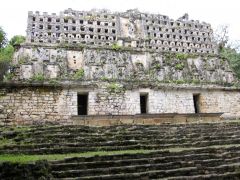
#155 Structure 33 In Yaxchilan _____________________ Content: Large structure built in Yaxchilan, which sits in the main center of the city. _______________________________ Style: This structure consists of one large room and three entrances. The building is elevated by two sets of inscribed stairs. The roof is the most noticeable feature, with its combed designs and niches filled with human figures. |
Context: It is though that this temple was either built by the ancient Mayan chief, Bird Jaguar, or dedicated to him by his son, Shield Jaguar, who took the throne later. Because of this, the temple is most defiantly meant to signify the Jaguar legacy in the Mayan monarchy. |
|
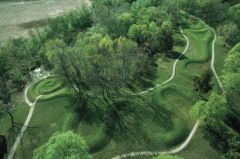
#156 Great Serpent Mound Adams County, southern Ohio Mississippian (eastern woodlands) 1070 C.E. _____________________ Content:
|
Context: The "mouth" of the serpent is thought to be the section used for religious, ceremonial purposes. This fits because, in ancient American cultures, the circle was common for being the perfect and most sacred shape. The image could be of the serpent swallowing an egg or was meant to show the serpent devouring the ceremonies that would have taking place on that area. |
|
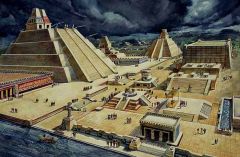
#157 Templo Mayor (main temple) Tenochtitlan (modern day Mexico City, Mexico) Mexica (Aztec) 125 C.E. _____________________ Content: Illustration of one of the most important and largest stepped-pyramid temples in the ancient Aztenchean city of Tenochtitlan, _______________________________ Style: At 90 feet high, the temples consisted of two separate, ceremonial temples constructed in the stepped pyramid style. Each temple was accessible by massive, steep staircases. At the foot of each staircase, there used to be large mounds made in the shapes of creatures that were meant to guard the temple's access. Inside, the temples, there were elaborate tunnels and levels that resricted access the deeper inside the pyramid. |
Context: Today, the site is in ruins, but it represented the founding of Tenichitilan and, later, Mexico City. Aztec empire was a thriving civilization with trade, developments, and governments. The two separate pyramids were meant to represent the two sacred mountains of Aztec culture. The temples were built upwards in order to reach closer to the gods in heaven. Each temple is dedicated to a separate deity, one including the god of the city Tenochtilan. The extreme slant of the staircases were meant to restrict the access to the sacred sites, and allowed for the religious leaders to stand at the top and allow for the ceremonies to be seen from most points in the city. This and many other temples of the Aztecs housed the culture's violent sacrifices. One such ceremony would consist of the deaths of prisoners from invading tribes. The warriors would have their hearts ripped out on the tope of the pyramids and there bodies kicked down all the stairs, and then have their dead bodies decapitated. When Spanish conquistadors saw this happening, they sread the romanticized, dramatic vision of the Aztecs to Europe and the empire gained a bloody, and war-like reputation. There is new information indicating that the infrastructure of the empires were just as elaborate as the tempples, with canals, vast agricultural lands, and power that spread out to the Caribbean. (Warrior ritual sacrifice) |
|

#157 The Coyolxauhqui Stone In the Templo Mayor _____________________ Content: A large, carved monolithic stone (weighing one ton) meant to be placed in one of the plazas of Tenochtitlan. _______________________________ Style: This stone is decorated with typical aztec designs made in low relief with the subtractive technique, with largely anthropomorphic subjects. |
Context: Stone was abundantly available in Mexico, which allowed the Aztecs to extraxt, transport, and shape, and carve great monolythic stones. The Coyolxauhqui Stone depicts one of the primary goddesses (a mythological being) of Aztecs s shown decapitated, and with detached limbs. The scenario is thought to show the Aztec Warrior sacrifice ceremony. The stone also also has an orbiting full moon that represents the goddess' status (her name is Coyolxsuhqui) as the moon goddess, she also has eagle feathers with a skull tied to her belt to represent her mother |
|
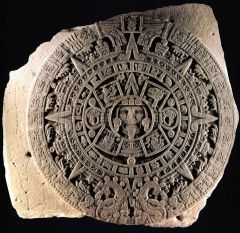
#157 Calendar Stone In Templo Mayor _____________________ Content: A monolithic, 24 ton, basalt stone carved with representations of a calendar found in the city center of Tenochititlan. _______________________________ Style: This piece is carved in an elaborate circular shape, with a face in the center and different radiating sections. The calander also has different symbols for months, days, and seasons. |
Context: In the Aztec culture, basalt stone was only made for sacred items. The center being in the center of the stone is meant to be the traditional mythological sea being that has often been found in the Aztec's creation myths. The four points decorated with emphasis are thought to be the four cardinal points. The circular shape of the stone represents time and space. The intricacies of the piece show the Aztec's knowledge of time, geometry, and physics (in order to move the large stone). Some of the symbols on the stone also could be representational of the ages that the Aztecs believed the earth had already passed through before their era (how old the earth was). The stone was most likely used as a sacrificial altar or as a tool to track astrological movements. |
|
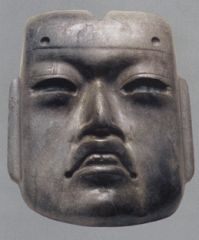
#157 Olmec-style Mask In Tenochtitlan _____________________ Content: Depiction of a god's face that is similar to that of an actual human. _______________________________ Style: The mask is made of Jade light and carved with a significant purpose of naturalistically depicting a human face. |
Context: The mask was used for ceremonial rituals in part of the Aztec Empire. The jade stone was one of the precious materials reserved for sacred pieces. The Olmecs eventually established their own style in art, which relied on an uncharacteristically representational and natural techniques not normally seen in the Aztec Empire. |
|
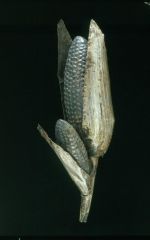
#158 Silver and gold maize cobs Inka 1400 - 1533 C.E. _____________________ Content: A metal work piece showing two corn cobs. _______________________________ Style: This piece was created out of silver and gold, shaped and etched into the likeness of two corn cobs. The piece is very representational and naturalistic in form. |
Context: The subject choice shows how the Inkan empire was able to thrive agriculturally, and how they found significance in the source of their sustenance. Precious metals, like the ones used in this piece, were abundant in the Andean region of this empire. The Inka obviously had the ability to extract the materials and manipulate them skillfully. Unfortunately, pieces like this are rare since the Spanish conquistadors took most of the valuables from the Inka. |
|

#159 Ruler's feather headdress (probably of Motecuhzoma II) Mexica (Aztec) 1428 - 1520 C.E. _____________________ Content: Headdress elaborately adored with the feathers of the Quetzal bird. _______________________________ Style: The headdress is made of natural materials like feathers, plant fibers, wood, leather, and other textiles, along with metallic embellishments. The colors and bright and rich, with slight patterns made by the placing of the textiles. |
Context: To create headdresses, the Mexica culture would catch the Quetzal bird, pluck the tail feathers, and then release them so they could continue to live and reproduce. The Aztecs understood the rarity of the species and made an effort not to impact the populations with their art. The headdress is thought to be that of the ancient Aztec leader, Motecuhzoma II, who was captured by the Spanish when they attacked the Mexica Empire. The headdress was then transferred to Europe as one of the many spoils of war. It was ineffectively restored in 1878, but has be redone more recently to revert the piece back to its traditional form. Throughout its travels around Europe, the headpiece lost the gold break that was traditionally wore with it, prompting museums to go from labeling it as a "hat" to labeling it as an "apron". |
|
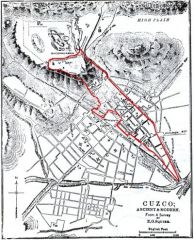
#160 City of Cusco (and plan) Central highlands of Peru Inka _____________________ Content: The main area of Cusco (outlined in red) was the center for the Empire, with streets and temples organized around it. _______________________________ Style: This sector of the city was planned out to be in the shape of the sacred puma, with the entire city representing a circular calendar. The streets are built diagonal, radiating out from the city center. Cusco also included a vast system of canals and satellite temples. Because of the calendar-like appearance, it is debated whether the city was organized according to the seasons and months. |
Context: The Inka Empire of Peru was one of the most advanced cultures of the time, with cities that included architecture that could withstand earthquakes, fortresses for protection, and numerous religious and agricultural sites. The city of Cusco began one of the largest centers for the entire Empire. The city was actually sacked many times by other tribes and had to be rebuilt. |
|
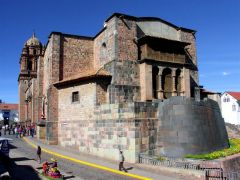
#160 Curved Inka wall of Qorikancha and church of Santo Domingo In City of Cusco _____________________ Content: An ancient Inkan wall, once part of a temple, that has now been surrounding by a Spanish. _______________________________ Style: This curved wall was part of an elevated site, built with equally cut polished black stones, which have been placed so tightly that nothing can fit between them. |
Context: The Spanish conquistador's takeover of the Inkan culture resulted in the partial demolition of this temple, which used to be a tribute to the sun god. But, because of the advanced construction and strength of this section, it was figured by the Spanish that it would cost less to simply keep the wall and use it as a foundation for the church. All the naturally occurring earthquakes in the region have since done damage to the Catholic church, but nothing has happened to the Inkan wall. The temple used to be covered in sheets of gold and the courtyard was thought to hold gold statues as well. When the Spanish conquered, they held the chief of Cusco captive and demanded a ransom of gold. So the people had to strip the temple of the gold in order to set their leader free. |
|
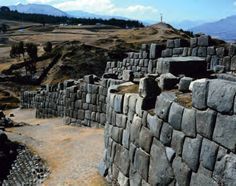
#160 Walls at Saqsa Waman (Sacsayhuaman) In the City of Cusco _____________________ Content: A massive wall that radiates out from Cusco and sits on top of a hill that overlooks the city. _______________________________ Style: Again, the stones making up this wall are expertly cut and stacked so there are no spaces or need for mortar. The wall is tiered with different levels and winds its way, with curved walls, for several hundred feet. |
Context: Because of the size and placement of the wall, with a clear view of the entire city, it is thought that the wall acted as a military fortress to protect the center of the city. |
|
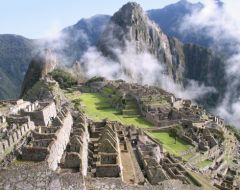
#161 City of Machu Picchu Central highlands, Peru Inka 1440 C.E. _____________________ Content: A multi-purpose satellite site of over 200 buildings perched high on an Andean mountain ridge, about 50 miles from Cusco. _______________________________ Style: The entire site was built using the dry stone wall technique (close filling stones and no mortar). The site was divided into an urban residential sector and an agricultural one. The religious, ceremonial section is placed past the residential areas and out at the end of the ridge. |
Context: Machu Picchu was discoverer in the late 1800's by an explorer, Hiram Bingham, who was sponsored by Yale. He started in Cusco and was eventually led to the site by local natives who knew of the city's existence and occasionally farmed the land. The story of Machu Picchu's discovery has been romanticized, as was common at the time for stories of archeology and exotic places. The site is theorized to be an ancient royal estate for the leaders of Cusco to escape to for occasional visits. Fortification was provided for by the cliffside that dropped down to the river valley, where one of the main rivers of the area runs. The cliffs were terraced all the way down and could be used for agriculture. The site is actually placed on the divide between two fault lines, but there has still been little overall damage to any of the structures. All the stone used to build was quarried from the site itself and the leftover chips were used to direct wanter into the city and down into the mountain instead of off the sides, preventing erosion and landslides. |
|
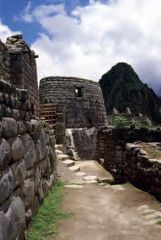
#161 Observatory In Machu Picchu _____________________ Content: A specific, curved structure, also known as the Temple of the Sun, used for tracking the sun during certain seasons. _______________________________ Style: Along with its identifiable curved wall, this structure also has three specific windows that align to the location of the sun during the summer and winter solstices. |
Context: Prior to the sites discovery, reconstruction, and establishment as a tourist site, Peruvian Villages were actually using the site for agricultural purposes, but kicked out. Thus arose a conflict between Yale and the Peruvian archeologists who claimed it was their right to conduct anything having to do with the site. Yale argued that the country did not have people advanced enough to take proper care of or reconstruct the site. |
|
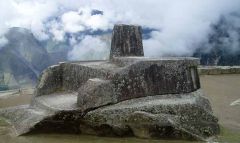
#161 Intihuatana Stone In Machu Picchu _____________________ Content: A ceremonial stone placed in the religious sector of Machu Picchu at the end of the site. _______________________________ Style: As a single, monolithic piece, this stone also relates to the solstices and casts significant shadows during different times of the day or year. It acts like a clock or calendar. On the winter solstice, the stone points directly to the sun. |
Context: The name came from the traditional, Peruvian language meaning "sun" and "tethering to". Together the name translates to "the hitching post of the sun". The Inka believed that the sun was held in its motions across the sky by this stone. |
|
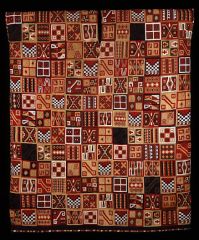
#162 All-T’oqapu tunic Inka 1450 - 1504 C.E. Central highlands, Peru Inka _____________________ Content: An Alpaca wool tunic worn by the Inkan king during ceremonies. _______________________________ Style: The garment was waved into small sectors of bright colors and patterns. Each square is though to hold the mantels of the different racial and social groups of the Inkan empire, with the overall motif of unity. The piece is slightly abstract and the wool has been dyed to create the different colors and patterns. |
Context: The Inka empire successfully utilized the craft of weaving and had the know-how to harvest the wool, spin it, and dye it. This piece is one of the earliest and most preserved. The stylistic elements were meant to represent the unification of the Inkan empire. It made sense then, to have the king wear the tunic as he was the sole, unified leader of the empire. |
|
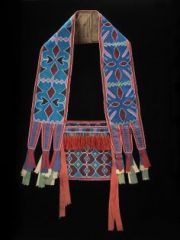
#163 Bandolier Bag Lenape (eastern Delaware) tribe 1850 C.E. _____________________ Content: A two pieced scarf-and-bag garment adorned with elaborate blue and red beadwork. _______________________________ Style: The color schemed beads are threaded onto cotton cloth with geometric designs and patterns. |
Context: This piece reflects the early interactions between native tribes in America and the first white settlers. The material, cotton, was something traded by the settlers and, by the late 1800's, almost entirely replaced traditional Native American textiles of hide. The designs as well carry influenced from European folk art and the crafts of weaving and embroidery. In 1812, however, did not recognize the sanctity of Indian tribes and prompted the exchange of ideas to end. Tribes reverted back to their traditional artistic styles and found ways to express their independence at a time when they were losing their individuality as people of North America. |
|
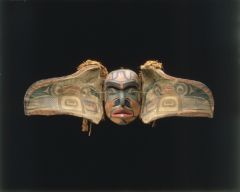
#164 Transformation Mask (open view) Kwakiutl, Northwest coast of Canada late 19th century _____________________ Content: A mask with the unique ability to open and close, revealing two separate carvings: one of an eagle and the other of a human face. _______________________________ Style: The outside of the mask is very zoomorphic, but the piece altogether is anthropomorphic as it blends the human face and the eagle head. The piece is entirely made from carved wood. The art was extremely function, meant to be actively used in ceremony. The interior of the mask has been designed with swirls and geometric paintings. |
Context: In the traditional ceremonies of this tribe, the mask would be worn and opened and closed rapidly using a string. The transition between the bird and human traits was meant to symbolize the interconnections between the eagle spirit and the human form. The ceremony represented the tribe's relationships with their surrounding animals and the spirits they were through to have held. |
|
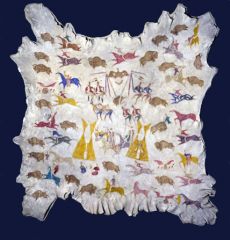
#165 Hide painting of Sun Dance attributed to Cotsiogo (Cadzi Cody), Eastern Shoshone, Wind River Reservation, Wyoming 1890 - 1900 C.E. _____________________ Content: A painting done on animal hide depicting the tribal life of the Shoshone. _______________________________ Style: Hide painting was a traditional style and usually depicted myths, tribal life, or orally told stories. In this scene, there are carious animals, men on horses hunting buffalo, women around the tipis, and the ceremony of the Sun Dance depicted in the center with the effigy of a bird emerging from it. Cadzi Cody's style was the first to become more representation and organic, instead of the geometric tradition of the tribe. |
Context: Hide painting originated among the Great Plain and Great Basin from the designs that were often painted in tipis. Eventually, it transferred over to an art form that required individual pieces of hide. At the time this piece was done, Native American art was only just beginning to become popular with the whites, who now wanted to obtain the art through purchasing and trade. The Sun Dance shown in the painting was an ancient ceremony in which the medicine man of the tribe was attached to a trees by a rope and stick that was speared through the medicine man's skin. The ceremony did not end until the stick ripped through the skin, liberating the man.
|
|
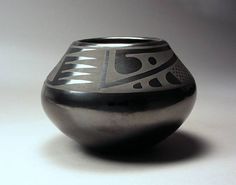
#166 Black-on-black ceramic vessel Maria Martínez and Julian Martínez Tewa, Puebloan, San Ildefonso Pueblo, New Mexico mid-20th century C.E. ____________________ Content: A black-on-black designed earthen ware designed after the ancient Anasazi and Pueblo traditions. _______________________________ Style: The black on black designing involved burnishing clay, with an underglaze gloss, in a dung (cow patties) fueled pit fire. The pit would then be lit on fire before being covered with dirt to keep the smoke in reduce the oxygen. |
Context: At the time the artist and her son, who did the designs, started producing theses, ancient styled pottery became collectable items. Maria learned how to make ceramics from her parents and sold her work early on through stands set up on Route 66, which catered to travelers and tourists going to California. Most all of the money from the wares went to the artist's tribe. |

